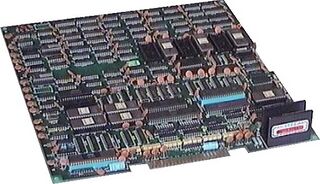Sega System 1
From Sega Retro

| |||||||||||||
| Sega System 1 | |||||||||||||
|---|---|---|---|---|---|---|---|---|---|---|---|---|---|
| Manufacturer: Sega Enterprises, Ltd. | |||||||||||||
|
The Sega System 1 (セガ システム 1) is an arcade platform officially debuted by Sega in 1983,[1] based on earlier 1982 prototype hardware. It is a Z80-based platform and the first in the decade-long "System" series of arcade boards.
The System 1 was a relatively popular arcade board for its day, supported not only by Sega, but by Japanese developers Coreland and VIC Tokai between 1983 and 1987. In 1985 it was succeeded by the slightly more powerful Sega System 2 board, though new games were released for both systems concurrently. Many of the System 1's games were ported to the SG-1000 and Sega Master System consoles.
Contents
Technical specifications
System 1
- Board composition: One board
- Master clock rate: 19.99982 MHz[2]
Graphics
- Graphics chipset:[2]
- Color palette: 4096[6]
- Colors on screen: 2048[2]
- Sprite plane: Line buffer, double buffering, 16 colors per sprite, sprite flipping, hardware collision detection[6][2]
- Tilemap sizes: 256×256 for both planes
Memory
- ROM: 136.25 KB
- Main: 48 KB
- Video: 80.25 KB (48 KB tiles, 32 KB sprites, 256 bytes palette)
- Sound: 8 KB
Prototype
Super Locomotive in 1982 ran on prototype arcade hardware that was very similar to the Sega System 1 later released in 1983. Super Locomotive had largely identical specifications, but with the following differences:[8][9][10]
Graphics
- Graphics chipset:
- Sega 315-5011 sprite line comparator: 16‑bit line buffer RAM (11.79648 MHz, 23.59296 MB/s), 7.86432 MHz sprite line buffer render clock, 3.93216 MHz sprite line buffer scan/erase/pixel clock[5]
- Video resolution: 248×224 (active), 256×256 (overscan)
- Pixel clock rate: 3.93216 MHz
- Refresh rate: 60 Hz
- Color palette: 1568
- Colors on screen: 768
- Sprite plane:
Memory
List of games
Note that Super Locomotive is listed as a System 1 game for using similar technology, but was not distributed on a System 1 board.
- 4-D Warriors (1985)
- Block Gal (1987)
- Brain (1986)
- Bullfight (1984)
- Choplifter (1985)
- Flicky (1984)
- Gardia (1986)
- I'm Sorry (1985)
- Mister Viking (1984)
- My Hero (1985)
- Ninja Princess (1985)
- Pitfall II: The Lost Caverns (1985)
- Rafflesia (1986)
- Regulus (1983)
- Spatter (1984)
- Star Jacker (1983)
- Super Locomotive (1982)
- SWAT (1984)
- Teddy Boy Blues (1985)
- Up'n Down (1983)
- Water Match (1984)
- Wonder Boy (1986)
Production credits
Photo gallery
References
- ↑ 1983 Timeline (Sega Corporation)
- ↑ 2.0 2.1 2.2 2.3 2.4 2.5 2.6 2.7 2.8 Sega System 1 / System 2 (MAME)
- ↑ File:Regulus System1 US Manual.pdf, page 8
- ↑ File:HangOn Schematics.pdf, page 4
- ↑ 5.0 5.1 5.2 5.3 Sega Pre-System 16 hardware notes (2004-03-29)
- ↑ 6.0 6.1 6.2 6.3 System1 / System 2 video hardware (MAME)
- ↑ File:Regulus System1 US Manual.pdf, page 14
- ↑ Super Locomotive (MAME)
- ↑ Super Locomotive video hardware (MAME)
- ↑ Sega Z80 Based Hardware (System 16)
- ↑ File:SS16CSTV2 Album JP Booklet.pdf, page 5
- ↑ https://www.4gamer.net/games/999/G999905/20210126043/ (Wayback Machine: 2021-02-05 15:00)
| Sega arcade boards |
|---|
| Originating in arcades |
|
77
78
79
80
81
82
83
84
85
86
87
88
89
90
91
92
93
94
95
96
97
98
99
|
| Console-based hardware |
|
84
85
86
87
88
89
90
91
92
93
94
95
96
97
98
99
00
01
02
03
04
05
06
07
08
09
10
11
12
13
14
|
| PC-based hardware |
|
05
06
07
08
09
10
11
12
13
14
15
16
17
18
19
20
21
22
23
|

